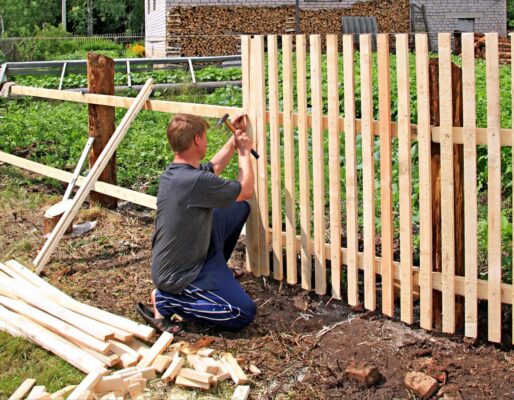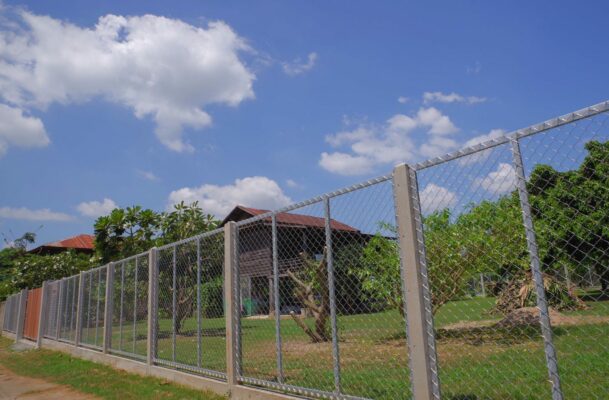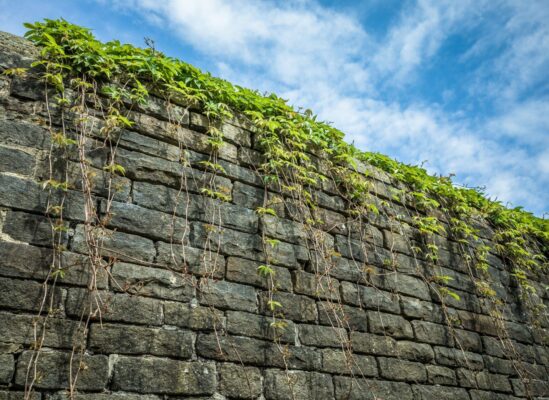Your home’s boundary wall has some specific purposes. Apart from protecting the overall property, it also adds to its beauty. This is why the design of the boundary wall, also known as compound wall, should ensure that it meets both these purposes. That said, safety and security remain the prime purposes of the compound wall and this should not be compromised for the look. With this in mind, let us explore the different boundary wall designs ideal for Indian homes.
Stone, brick and concrete compound walls

Source: Shutterstock
This has been the preferred choice to build compound walls in India. Not only are solid boundary walls made of stone, brick or concrete robust and secure but they also have a long life and the ability to withstand all weathers.
Various patterns and designs could be created using these three materials, to create fancy boundary walls.
See also our pictorial guide on Boundary Wall Design With Grill

Source: Shutterstock
See also: A pictorial guide on stone cladding
Wood and wood panel boundary wall designs

Source: Shutterstock
The charm of wooden fencing is undeniable. This is why fences made of wooden planks and logs, are common the world over. Obviously, there are a variety of benefits wooden fencing offers.
- With the natural look, it looks simply gorgeous.
- Comparatively speaking, it is easy to install.
- When compared to some other materials used for boundary walls it is more affordable.
- More importantly, when going for a wooden fencing, you are basically going for an eco-friendly boundary wall option.
- There is a wide variety of designs available in the market if wood if your choice for creating a boundary wall or fencing.
There are innumerable designs you could pick from, while creating a boundary wall made of wood or wooden elements. However, this fencing will not last more than a decade or so, under extreme weather conditions.
Metal compound wall design

Source: Shutterstock
Metal compound walls are ideal for Indian homes, because of the safety it offers, its all-weather nature and cost effectiveness. Painting it once every two years with a colour of your choice, is good enough for it to remain as good as new for years. Moreover, the sky’s the limit for designs, if you are selecting metal to build a compound wall.

Source: Shutterstock
Polyvinyl chloride fencing (PVC fencing)
PVC or polyvinyl chloride has gained popularity all over the world as fencing material. Apart from being low maintenance, pest-free and cost-effective, PVC is also stylish and robust. Such a boundary wall could last you nearly 50 years.

Source: Shutterstock
Combining materials for the boundary wall
You could also combine various materials – wood with metal, or brick with wood, or concrete with metal, or bricks with a bit of greens – to create something different.

Source: Shutterstock
Stone-clad compound wall
Stone cladding works brilliantly for compound wall designs. This would help the wall withstand moisture, as well as heat, while also providing visual appeal to your boundary wall.

Source: Shutterstock

Source: Shutterstock
The green compound wall
To go the eco-friendly way, this could work perfectly. To ensure safety, you could work with a combination/wooden slabs of part concrete wall and part green wall.

Source: Shutterstock

Source: Shutterstock
On a standalone basis, they work quite well to demarcate areas within the compound wall, too.

Source: Shutterstock
How to construct a boundary wall / compound wall
Height: The height of the boundary wall decides how protected your property is from outsiders’ view. Pick a boundary design, depending on whether or not you want the property to be seen.
Area: The compound wall must be constructed, keeping in mind all regulations and without encroaching on public or private land.
Look: The look and feel of the boundary wall should be in-sync with that of the property’s overall design.
Construction: Use professional help to get the job done faster and effectively.
Boundary wall Vastu tips
Vastu experts are of the opinion that the boundary wall should be higher and thicker on the south and the west side, as compared to the north and the east side. This would help the structure block severe sun rays entering the property from the south-west direction while permitting entry to the much-needed rays from the north-east side. Experts also opine that the boundary wall should be built before the property construction begins, in the south-west direction of the property. It is advised that the gate should not be placed in the south side or extreme corners of the boundary wall.
Key things to remember
Think beyond the look: Even though looks are quite important, when it comes to the boundary walls, be mindful of the fact that it is an essential external element. The boundary wall needs to be tough and sturdy enough to withstand the extreme elements of nature, such as light, water, dust, etc.
Regular repairs are a must: Also note that the boundary wall has to be repaired more often than the interiors of your home, for it to have a long life. This means that you not only have to apply a fresh coat of paint every couple of years, you also have to invest in getting the material checked for its functionality, from time to time. As water does a lot of damage to boundary walls, you have to make arrangements to ensure that it does not seep into the material. This is precisely why wood might not be a great choice for boundary walls.
Engage in DIY tasks only if you have expert knowledge: It is quite fulfilling to engage in do-it-yourself projects, to create your boundary wall. However, unless you have the expertise and skill to carry out the task flawlessly, we recommended that you hire professionals to do the job for you. Even the smallest of engineering defect could result in the whole structure going bad.
Do not compromise on security: Aesthetic beauty could play a secondary role but the compound wall must meet its very basic purpose of providing security.
FAQs
What is the standard height of a compound wall?
The compound wall or boundary wall is generally four to six ft in height.
What materials can be used for constructing compound walls?
Compound walls can be made of bricks, stone, concrete, metal, wooden materials, or PVC.

An alumna of the Indian Institute of Mass Communication, Dhenkanal, Sunita Mishra brings over 16 years of expertise to the fields of legal matters, financial insights, and property market trends. Recognised for her ability to elucidate complex topics, her articles serve as a go-to resource for home buyers navigating intricate subjects. Through her extensive career, she has been associated with esteemed organisations like the Financial Express, Hindustan Times, Network18, All India Radio, and Business Standard.
In addition to her professional accomplishments, Sunita holds an MA degree in Sanskrit, with a specialisation in Indian Philosophy, from Delhi University. Outside of her work schedule, she likes to unwind by practising Yoga, and pursues her passion for travel.
[email protected]











